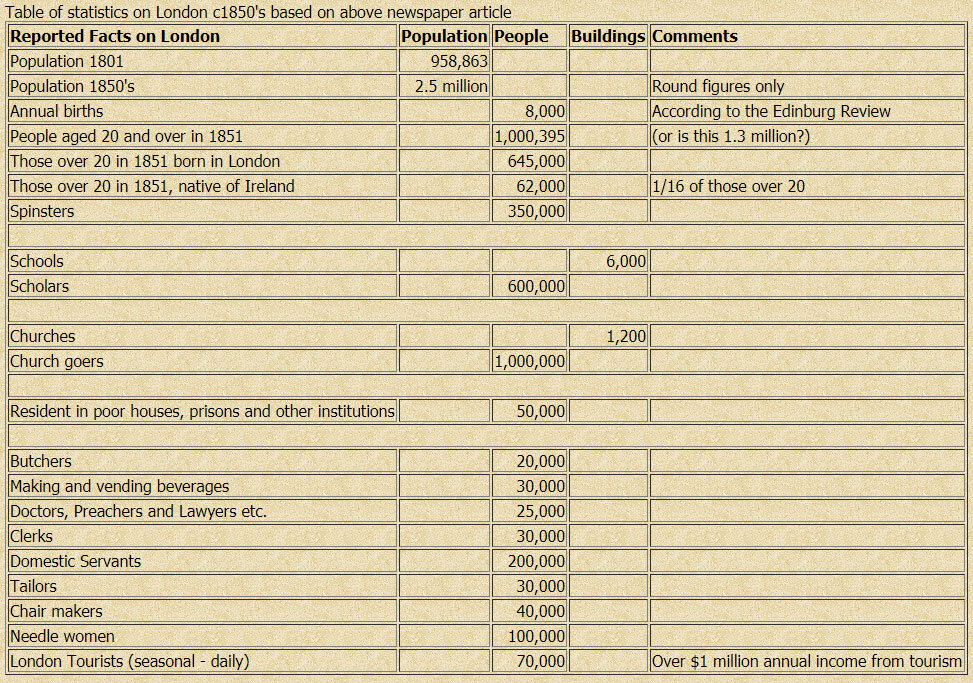The Vastness of London - c1850's
WE Americans are so accustomed to expatiating on the rapid growth of our cities, that most of us are surprised to hear that the capitals of Europe increase nearly as fast. The growth of Paris, Vienna and Berlin, on the continent, and of London, Liverpool, Glasgow and Manchester, in England, have been especially rapid. But no city in the old world has thriven like the great British metropolis. In 1801, for example, the population of London was 958,863; it is now two millions and a half; in other words, at the beginning of the century it was hardly more than a third as large as it is at present.
We think Philadelphia, with its half a million of inhabitants, is a large town; but London is five times as large. In fact, the latter city contains nearly as many inhabitants as the State of Pennsylvania, and more than all the great cities of the United States together. Nor does there seem, at present, any likelihood of this enormous metropolis decreasing in size. On the contrary, there is every indication of its continued growth. The sewerage commissioners, in view of its probable necessities in the future, are already projecting a drainage for six millions of inhabitants, or population which London will yet contain, if the increase goes on for half a century at the present ratio.
It is curious to examine the statistics in detail of such a vast metropolis. Every year there are eight thousand children born in London, according to the Edinburg Review – a competent authority. Yet the majority of the adult population, in spite of this, is country born, there having been, at the last census, out of one million three hundred and ninety-five persons, twenty years old and upwards, only six hundred and forty-five thousand born in London. Every sixteenth person of full age is a native of Ireland. There is always a permanent stock on hand, so to speak, of three hundred and fifty thousand marriageable but unmarried women.
There are six hundred thousand scholars, six thousand schools, twelve hundred places of worship, and a million church-going people. Fifty thousand persons are always resident in poor houses, prisons, and other institutions, where they are fed out of public or private resources. Twenty thousand individuals are engaged constantly in killing and selling animal food; thirty thousand in making and vending beverages; twenty-five thousand in doctoring, preaching, and managing lawsuits. To complete the catalogue, there are thirty thousand clerks; two hundred thousand domestic servants; thirty thousand tailors; forty thousand chair-makers, and one hundred thousand needle women.
In Horace Mayhew’s work, and in others, of similar character, may be found statistics as to how this enormous population is fed. London has the richest as well as the poorest people in the world among its inhabitants. Thousands of persons get up, every morning, without knowing how they are to buy a breakfast. On the other hand, there are during the fashionable season, seventy thousand people in London, who have nothing to do but to amuse themselves. Several wealthy men, most of them noblemen, own whole squares of houses and stores, and receive income of above a millions dollars, annually, from this source.
There is one acre of ground, in the British metropolis, which pays the interest, on a long lease, of four millions of dollars; and several that are worth, estimated in this not excessive way, from two to three millions. Ancient Rome has always been considered the richest and most populous city that ever existed. But the best historical students concede that London already surpasses what that city was, even in its palmiest* days; and even those who rate the population of old Rome at a higher figure confess that London, before the end of the century will be ahead.
________________________________________
*Palmiest – Prosperous/flourishing.

